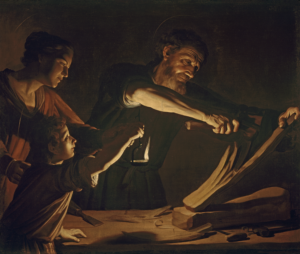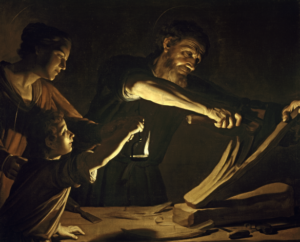The Holy Family in the Carpenter Shop
Gerrit van Honthorst
Below the image, click play to listen.
Art historian Georges Marlier describes The Holy Family in the Carpenter Shop as “a magnificent work which equals the most beautiful Caravaggio.”
Oil on canvas
Dutch, 1592–1656

Click on the links throughout the article to view additional artists’ works and reference material.
Gerrit van Honthorst was a Dutch painter active during the early 17th century. Born in Utrecht, Holland in 1592, he was trained as an artist, as were two of his brothers. However, Gerrit became the most successful painter in his family. He was also the most famous member of a group called the “Utrecht Caravaggisti,” or those following the style of Michelangelo Merisi da Caravaggio in the northern European area called the Utrecht.
Honthorst is best known for taking Caravaggio’s example of dramatically using natural light and shadow and adapting the technique for nocturnal scenes with artificial light such as candles or lanterns to illuminate his paintings. This style trait gave him the nickname “Gherardo delle Notti” or “Gerard of the Night.”
Honthorst first studied in Utrecht, then lived and worked in Italy for several years before returning to the northern Netherlands in 1620. In 1622, he became a member of the Utrecht Guild of St. Luke and eventually served as its dean in the late 1620’s. Although Honthorst attracted international attention long before becoming a member of the guild, it was during this time, that he began to diversify from the Caravaggesque style by using less artificial light in his major works and made an extremely well-received visit to England, where he was given English citizenship and a lifetime pension (1628). After his return to Utrecht, his international reputation grew widely, especially among the royal and courtly circles in England and other nations.
M&G’s painting, The Holy Family in the Carpenter Shop, returns to the museum this month from an extended loan to the Uffizi Gallery in Florence, Italy, which featured a monograph exhibition showing Honthorst’s lifetime of work.
M&G’s painting is a classic example of the Utrecht Caravaggisti style of painting. The canvas is illuminated by a single candle-lit lantern, and the scene is both nocturnal and heavily shadowed. Honthorst depicts Mary, clothed in her symbolic red garments, helping a young Jesus hold the lantern high so that Joseph can see to carve in his woodshop. This portrayal invites the viewer into the intimate setting while also placing the family in an ordinary work environment.
Mollie Nelson, former M&G graduate assistant
Published in 2015
Oil on canvas
Dutch, 1592–1656

All museums have at least one or two works that visitors love to see again and again. First-time visitors often comment on their preferences after a tour through the galleries, and regular patrons tell us that they enjoy returning to see their favorite works. M&G’s Holy Family in the Carpenter Shop by Gerrit van Honthorst is one such crowd pleaser.
Honthorst’s mastery of lighting effects was inspired by the works of Caravaggio during a sojourn to Italy around 1612 or 1620. Even though Caravaggio only produced two known night paintings which depict artificial lighting such as a candle or a torch, Honthorst and a group of other Dutch artists from Utrecht followed this genre’s techniques and became known as the “Candlelight Painters.” In fact, the Italians gave Gerrit van Honthorst the nickname, Gherardo delle Notti, meaning “Gerard of the Night Scenes.”
For the viewer the primary, gripping element is the effect of light in the painting. Mary, Joseph, and Christ are gathered in a plain, dark room with a soft, warm light illuminating their forms from out of the darkness. Honthorst’s proficiency and sensitivity are noted in his ability first to concentrate the most intense light on the arms of Christ and Joseph and then subtly diffuse the beam as it stretches away from the light source. The emotional effect of the soft lighting is heightened by the characters’ gentle, loving facial expressions as well as the simple, natural portrayal of their manner. Christ holds the oil lamp while Mary carefully steadies His hand in order to position the flame for Joseph to see his work and to prevent Jesus from burning Himself.
In this favored work of M&G patrons, the meaning evoked by the light is as equally compelling as the painterly technique. Although Christ is but a child in the scene, the lamp which He grasps metaphorically alludes to the declaration of an adult Christ, “I am the light of the world: he that followeth me shall not walk in darkness, but shall have the light of life” (John 8:12). Scripture further describes Christ in these words: “In him was life; and the life was the light of men. And the light shineth in darkness; and the darkness comprehended it not” (John 1:4-5). Perhaps another layer of Biblical significance is present in the work; as the youth eagerly looks to His father to please him and help him, the act faintly implies not only a family value or work ethic of Honthorst’s time, but also a Biblical injunction to children to obey and honor their parents (Ephesians 6:1, 2).
In order to fully appreciate the impression and effect of this remarkable work, come and view the painting for yourself. You will surely come to understand why this painting has become the favorite of so many.
Published in 2013
Sign up here to receive M&G’s monthly update and collection news!
We can speak for your retirement group, civic club, church fellowship, or book club. Contact us here or at 864-770-1331.
Make a Gift to M&G to help our current work and future plans.
M&G at BOB JONES UNIVERSITY; 1700 Wade Hampton Blvd - Greenville, SC 29614